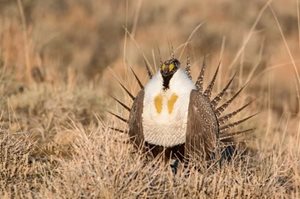
Wyoming G & F 1-24-2017
Representatives from Wyoming’s broad coalition who have helped shape and implement the state’s strategy for conserving the Greater sage-grouse are confident that Wyoming’s plan will remain intact and effective with a new presidential administration in place.
The Wyoming Sage Grouse Implementation Team (SGIT) will celebrate its 10th anniversary in 2017. The SGIT and local working groups, which have been active for longer than 10 years, bring together many diverse people who care about Wyoming and the wildlife, the land, and the jobs that are sustained here. Members of the SGIT include representatives from state and federal government, agriculture/ranching, industry, conservation groups, local landowners, and others.
Through an unprecedented collaborative process among Wyoming stakeholders, the SGIT developed a strategy for conserving the Greater sage-grouse, which was ultimately put into effect through Governor Dave Freudenthal’s sage-grouse executive order and subsequently updated through Governor Matt Mead’s executive orders.
Members of the SGIT believe that because Wyoming dealt with this challenge through collaboration, all sides have skin in the solution making the strategy all the more resilient.
Joy Bannon, who represents sportsmen as Field Director with the Wyoming Wildlife Federation says, “At the end of the day, the reason our Greater sage-grouse management plan will survive a new national administration is due to SGIT’s diverse collaborative process and strong core area management strategy.”
Bannon also points out that in a September 2015 quote by the selected Secretary of the Department of Interior, Montana Rep. Ryan Zinke, said, he “firmly believes state-driven solutions are the best approach to create a middle ground to protect the species.”
Brian Rutledge, VP The National Audubon Society, and Director of the Sagebrush Ecosystem Initiative represents conservation on the SGIT. He says, “Wyoming continues, through its Sage Grouse Implementation Team, to pilot the appropriate use of the U.S. Endangered Species Act. This long-term and community based team has built a conservation plan, that protects the Greater sage-grouse and well over 350 vertebrate species of sagebrush animals. The Act was written to insure state efforts and the Wyoming plan has and continues to achieve the goal of avoiding the necessity of listing.”
Other successful outcomes from the SGIT include additional funding for sage-grouse conservation. The Natural Resource Conservation Services (NRCS) fully supports and adheres to the Governor’s Sage Grouse Executive Order, according to Astrid Martinez, State Conservationist for the NRCS “Further, we utilized the sage-grouse core areas identified in the Executive Order when planning our Sage Grouse Initiative 2.0 program and willingly prioritize funding to those same geographic regions in order to protect and maximize the conservation values of these important working landscapes.”
The NRCS has committed an additional $211 Million to sage-grouse conservation across 11 western states. In fiscal year 2016, Wyoming NRCS received about $2.5M for financial assistance programs and another $1M for conservation easements.
Those representing Wyoming’s leading industries are also optimistic about the future of Wyoming’s strategy and sage-grouse. “For every business who wants to succeed in the 21st century, conservation has to be core to strategic planning as well as day-to-day operational activities,” notes Fred von Ahrens, Tronox Alkali’s Manufacturing Director.
Esther Wagner, Vice President – Public Lands, for the Petroleum Association of Wyoming, points out the value in Wyoming’s sage-grouse strategy being designed to conserve the species while also allowing for multiple-uses and for Wyoming’s economy to remain intact. “With Wyoming having the highest percentage of people working in the mining industry, which includes all energy extraction of any state in the country, we believe energy development and wildlife conservation can continue to co-exist in Wyoming. Collaborative state-level efforts are the best way to meet these objectives.”
Another important aspect that adds strength to Wyoming’s sage-grouse strategy is that it includes federal agencies, as half of the state is made up of federally managed lands. Buddy Green, Deputy State Director for Resource Policy and Management, in the BLM’s Wyoming State office says, “As a member of the Governor’s Sage-Grouse Implementation Team for the past six years, I can safely say it is an excellent example of collaboration. These are good people working hard to find solutions or recommendations for some very tough issues.”
The U.S. Fish and Wildlife Service, which is the federal agency responsible for making the decision not to list Greater sage-grouse in 2015 believes this strategy is a conservation success story. The U.S. Fish and Wildlife Service also has recognized Wyoming’s strategy for its effectiveness in reducing threats to the Greater sage-grouse while maintaining the multiple land uses and economic resources upon which Wyoming depends. As Tyler Abbott, Field Supervisor, for the US Fish and Wildlife Service Wyoming Ecological Services Field Office points out, ”We believe that the Wyoming Core Area Strategy, and the incorporation of this strategy into the Federal land management plans will continue to be a good model for the meaningful conservation of the Greater sage-grouse.”
